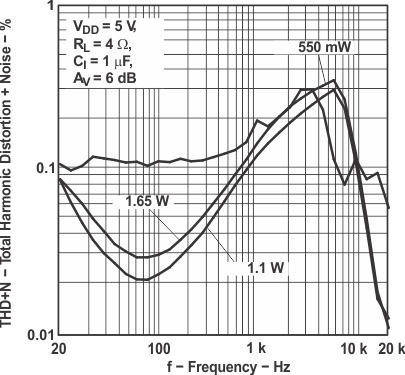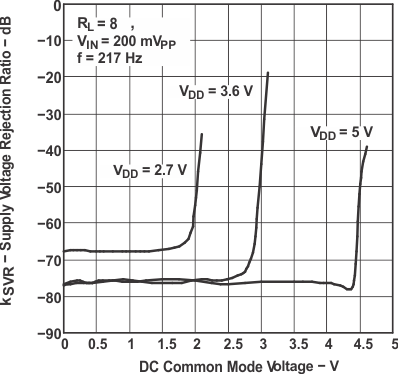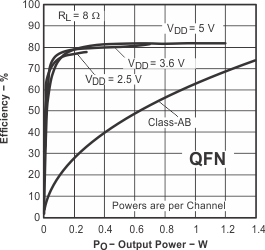JAJS219F December 2004 – March 2017 TPA2012D2
PRODUCTION DATA.
- 1 特長
- 2 アプリケーション
- 3 概要
- 4 改訂履歴
- 5 Device Comparison Table
- 6 Pin Configuration and Functions
- 7 Specifications
- 8 Parameter Measurement Information
- 9 Detailed Description
- 10Application and Implementation
- 11Power Supply Recommendations
- 12Layout
- 13デバイスおよびドキュメントのサポート
- 14メカニカル、パッケージ、および注文情報
パッケージ・オプション
メカニカル・データ(パッケージ|ピン)
サーマルパッド・メカニカル・データ
- RTJ|20
発注情報
7 Specifications
7.1 Absolute Maximum Ratings
over operating free-air temperature range (unless otherwise noted)(1)| MIN | MAX | UNIT | ||
|---|---|---|---|---|
| Supply voltage, VSS (AVDD, PVDD) | Active mode | –0.3 | 6 | V |
| Shutdown mode | –0.3 | 7 | ||
| Input voltage, VI | –0.3 | VDD + 0.3 | V | |
| Continuous total power dissipation | See Dissipation Rating Table | |||
| Operating junction temperature, TJ | –40 | 150 | °C | |
| Storage temperature, Tstg | –65 | 150 | °C | |
(1) Stresses beyond those listed under Absolute Maximum Ratings may cause permanent damage to the device. These are stress ratings only, which do not imply functional operation of the device at these or any other conditions beyond those indicated under Recommended Operating Conditions. Exposure to absolute-maximum-rated conditions for extended periods may affect device reliability.
7.2 ESD Ratings
| VALUE | UNIT | |||
|---|---|---|---|---|
| V(ESD) | Electrostatic discharge | Human-body model (HBM), per ANSI/ESDA/JEDEC JS-001(1) | ±2000 | V |
| Charged-device model (CDM), per JEDEC specification JESD22-C101(2) | ±1500 | |||
(1) JEDEC document JEP155 states that 500-V HBM allows safe manufacturing with a standard ESD control process.
(2) JEDEC document JEP157 states that 250-V CDM allows safe manufacturing with a standard ESD control process.
7.3 Recommended Operating Conditions
over operating free-air temperature range (unless otherwise noted)| MIN | MAX | UNIT | ||
|---|---|---|---|---|
| VSS | Supply voltage, AVDD, PVDD | 2.5 | 5.5 | V |
| VIH | High-level input voltage, SDL, SDR, G0, G1 | 1.3 | V | |
| VIL | Low-level input voltage, SDL, SDR, G0, G1 | 0.35 | V | |
| TA | Operating free-air temperature | –40 | 85 | °C |
7.4 Thermal Information
| THERMAL METRIC(1) | TPA2012D2 | UNIT | ||
|---|---|---|---|---|
| YZH (DSBGA) | RTJ (WQFN) | |||
| 16 PINS | 20 PINS | |||
| RθJA | Junction-to-ambient thermal resistance | 71.4 | 34.6 | °C/W |
| RθJC(top) | Junction-to-case (top) thermal resistance | 0.4 | 34.3 | °C/W |
| RθJB | Junction-to-board thermal resistance | 14 | 11.5 | °C/W |
| ψJT | Junction-to-top characterization parameter | 1.8 | 0.4 | °C/W |
| ψJB | Junction-to-board characterization parameter | 13.3 | 11.6 | °C/W |
| RθJC(bot) | Junction-to-case (bottom) thermal resistance | — | 3.2 | °C/W |
(1) For more information about traditional and new thermal metrics, see the Semiconductor and IC Package Thermal Metrics application report.
7.5 Electrical Characteristics
TA = 25°C (unless otherwise noted)| PARAMETER | TEST CONDITIONS | MIN | TYP | MAX | UNIT | ||
|---|---|---|---|---|---|---|---|
| |VOO| | Output offset voltage (measured differentially) | Inputs ac grounded, AV = 6 dB, VDD = 2.5 to 5.5 V | 5 | 25 | mV | ||
| PSRR | Power supply rejection ratio | VDD = 2.5 to 5.5 V | –75 | –55 | dB | ||
| Vicm | Common-mode input voltage | 0.5 | VDD – 0.8 | V | |||
| CMRR | Common-mode rejection ration | Inputs shorted together, VDD = 2.5 to 5.5 V | –69 | –50 | dB | ||
| |IIH| | High-level input current | VDD = 5.5 V, VI = VDD | 50 | µA | |||
| |IIL| | Low-level input current | VDD = 5.5 V, VI = 0 V | 5 | µA | |||
| IDD | Supply current | VDD = 5.5 V, no load or output filter | 6 | 9 | mA | ||
| VDD = 3.6 V, no load or output filter | 5 | 7.5 | |||||
| VDD = 2.5 V, no load or output filter | 4 | 6 | |||||
| Shutdown mode | 1.5 | µA | |||||
| rDS(on) | Static drain-source on-state resistance | VDD = 5.5 V | 500 | mΩ | |||
| VDD = 3.6 V | 570 | ||||||
| VDD = 2.5 V | 700 | ||||||
| Output impedance in shutdown mode | V(SDR, SDL)= 0.35 V | 2 | kΩ | ||||
| f(sw) | Switching frequency | VDD = 2.5 V to 5.5 V | 250 | 300 | 350 | kHz | |
| Closed-loop voltage gain | G0, G1 = 0.35 V | 5.5 | 6 | 6.5 | dB | ||
| G0 = VDD, G1 = 0.35 V | 11.5 | 12 | 12.5 | ||||
| G0 = 0.35 V, G1 = VDD | 17.5 | 18 | 18.5 | ||||
| G0, G1 = VDD | 23.5 | 24 | 24.5 | ||||
| OPERATING CHARACTERISTICS, RL = 8 Ω | |||||||
| PO | Output power (per channel) | RL = 8 Ω | VDD = 5 V, f = 1 kHz, THD = 10% |
1.4 | W | ||
| VDD = 3.6 V, f = 1 kHz, THD = 10% |
0.72 | ||||||
| RL = 4 Ω | VDD = 5 V, f = 1 kHz, THD = 10% |
2.1 | |||||
| THD+N | Total harmonic distortion plus noise | PO = 1 W, VDD = 5 V, AV = 6 dB, f = 1 kHz | 0.14% | ||||
| PO = 0.5 W, VDD = 5 V, AV = 6 dB, f = 1 kHz | 0.11% | ||||||
| Channel crosstalk | f = 1 kHz | –85 | dB | ||||
| kSVR | Supply ripple rejection ratio | VDD = 5 V, AV = 6 dB, f = 217 Hz | –77 | dB | |||
| VDD = 3.6 V, AV = 6 dB, f = 217 Hz | –73 | ||||||
| CMRR | Common mode rejection ratio | VDD = 3.6 V, VIC = 1 Vpp, f = 217 Hz | –69 | dB | |||
| Input impedance | Av = 6 dB | 28.1 | kΩ | ||||
| Av = 12 dB | 17.3 | ||||||
| Av = 18 dB | 9.8 | ||||||
| Av = 24 dB | 5.2 | ||||||
| Start-up time from shutdown | VDD = 3.6 V | 3.5 | ms | ||||
| Vn | Output voltage noise | VDD = 3.6 V, f = 20 to 20 kHz, inputs are ac grounded, AV = 6 dB |
No weighting | 35 | µV | ||
| A weighting | 27 | ||||||
7.6 Dissipation Rating Table
| PACKAGE | TA = 25°C POWER RATING(1) |
DERATING FACTOR |
TA = 75°C POWER RATING |
TA = 85°C POWER RATING |
|---|---|---|---|---|
| RTJ | 5.2 W | 41.6 mW/°C | 3.12 W | 2.7 W |
| YZH | 1.2 W | 9.12 mW/°C | 690 mW | 600 mW |
(1) This data was taken using 2-oz trace and copper pad that is soldered directly to a JEDEC standard 4-layer 3 in × 3 in PCB.
7.7 Typical Characteristics
 Figure 1. Total Harmonic Distortion
Figure 1. Total Harmonic Distortionvs Output Power
 Figure 3. Total Harmonic Distortion
Figure 3. Total Harmonic Distortionvs Output Power
 Figure 5. Total Harmonic Distortion vs Frequency
Figure 5. Total Harmonic Distortion vs Frequency
 Figure 7. Total Harmonic Distortion vs Frequency
Figure 7. Total Harmonic Distortion vs Frequency
 Figure 9. Total Harmonic Distortion vs Frequency
Figure 9. Total Harmonic Distortion vs Frequency
 Figure 11. Supply Current vs Shutdown Voltage
Figure 11. Supply Current vs Shutdown Voltage
 Figure 13. Supply Current vs Output Power
Figure 13. Supply Current vs Output Power
 Figure 15. Crosstalk vs Frequency
Figure 15. Crosstalk vs Frequency
 Figure 17. Power Supply Rejection Ratio
Figure 17. Power Supply Rejection Ratiovs Frequency
 Figure 19. Common-Mode Rejection Ratio
Figure 19. Common-Mode Rejection Ratiovs Common-Mode Input Voltage
 Figure 21. GSM Power Supply Rejection vs Time
Figure 21. GSM Power Supply Rejection vs Time
 Figure 23. Supply Voltage Rejection Ratio
Figure 23. Supply Voltage Rejection Ratiovs DC Common-Mode Voltage
 Figure 25. Power Dissipation vs Output Power
Figure 25. Power Dissipation vs Output Power
 Figure 27. Efficiency vs Output Power
Figure 27. Efficiency vs Output Power
 Figure 29. Power Dissipation vs Output Power
Figure 29. Power Dissipation vs Output Power
 Figure 31. Efficiency vs Output Power
Figure 31. Efficiency vs Output Power
 Figure 33. Output Power vs Load Resistance
Figure 33. Output Power vs Load Resistance
 Figure 2. Total Harmonic Distortion
Figure 2. Total Harmonic Distortionvs Output Power
 Figure 4. Total Harmonic Distortion
Figure 4. Total Harmonic Distortionvs Output Power
 Figure 6. Total Harmonic Distortion vs Frequency
Figure 6. Total Harmonic Distortion vs Frequency
 Figure 8. Total Harmonic Distortion vs Frequency
Figure 8. Total Harmonic Distortion vs Frequency
 Figure 10. Total Harmonic Distortion vs Frequency
Figure 10. Total Harmonic Distortion vs Frequency
 Figure 12. Supply Current vs Supply Voltage
Figure 12. Supply Current vs Supply Voltage
 Figure 14. Supply Current vs Output Power
Figure 14. Supply Current vs Output Power
 Figure 16. Crosstalk vs Frequency
Figure 16. Crosstalk vs Frequency
 Figure 18. Power Supply Rejection Ratio
Figure 18. Power Supply Rejection Ratiovs Frequency
 Figure 20. Common-Mode Rejection Ratio
Figure 20. Common-Mode Rejection Ratiovs Frequency
 Figure 22. Power Supply Rejection vs Frequency
Figure 22. Power Supply Rejection vs Frequency
 Figure 24. Power Dissipation vs Output Power
Figure 24. Power Dissipation vs Output Power
 Figure 26. Efficiency vs Output Power
Figure 26. Efficiency vs Output Power
 Figure 28. Power Dissipation vs Output Power
Figure 28. Power Dissipation vs Output Power
 Figure 30. Efficiency vs Output Power
Figure 30. Efficiency vs Output Power
 Figure 32. Output Power vs Supply Voltage
Figure 32. Output Power vs Supply Voltage